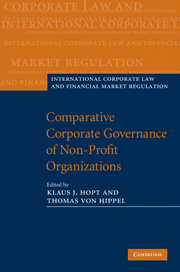Book contents
- Frontmatter
- Contents
- List of contributors
- Preface
- Abbreviations
- PART I Economic findings and theories on nonprofit organizations
- 1 The nonprofit sector: introductory remarks
- 2 Good and not so good governance of nonprofit organizations: factual observations from the USA and Europe
- 3 Economic theories of nonprofit organizations
- 3.1 The economics of nonprofit organizations
- 3.2 Principal–agent theory and nonprofit accountability
- PART II The nonprofit sector: private law, trust law, tax law in selected countries
- PART III The board of nonprofit organizations
- PART IV Good governance of nonprofit organizations: activities and regulatory problems
- PART V Good governance of nonprofit organizations: self-regulation, disclosure and supervision
- Index
- References
3.1 - The economics of nonprofit organizations
from 3 - Economic theories of nonprofit organizations
Published online by Cambridge University Press: 05 August 2011
- Frontmatter
- Contents
- List of contributors
- Preface
- Abbreviations
- PART I Economic findings and theories on nonprofit organizations
- 1 The nonprofit sector: introductory remarks
- 2 Good and not so good governance of nonprofit organizations: factual observations from the USA and Europe
- 3 Economic theories of nonprofit organizations
- 3.1 The economics of nonprofit organizations
- 3.2 Principal–agent theory and nonprofit accountability
- PART II The nonprofit sector: private law, trust law, tax law in selected countries
- PART III The board of nonprofit organizations
- PART IV Good governance of nonprofit organizations: activities and regulatory problems
- PART V Good governance of nonprofit organizations: self-regulation, disclosure and supervision
- Index
- References
Summary
Introduction
I have been asked to address, in general terms, economic theories of nonprofit organizations. It is of course impossible, in the course of a short essay, to cover this subject comprehensively. Consequently, I'll limit my focus to a set of particular themes that seem to me especially important, and I'll try to relate those themes to the problems of regulation that are confronted in designing the legal framework for nonprofit organizations.
Structure and role
The defining characteristic of a nonprofit organization, in economic terms, is that it is bound by a “nondistribution constraint” which prohibits the distribution of the organization's earnings or assets – that is, anything beyond reasonable compensation for services rendered – to any person who exercises control over the organization, including its officers, directors, and members. In effect, nonprofit firms are barred from having owners. Rather, the two attributes of ownership – control and the right to residual earnings – must be placed in different hands.
The advantage offered by the nonprofit form is that, in some circumstances, it may offer consumers of an organization's services greater protection from exploitation than they would enjoy if the organization were organized as a profit-seeking business organization, such as a partnership or an incorporated joint stock company. The nondistribution constraint makes it difficult for the organization's managers to profit by providing fewer or worse services than they promise to deliver.
- Type
- Chapter
- Information
- Publisher: Cambridge University PressPrint publication year: 2010
References
- 5
- Cited by

